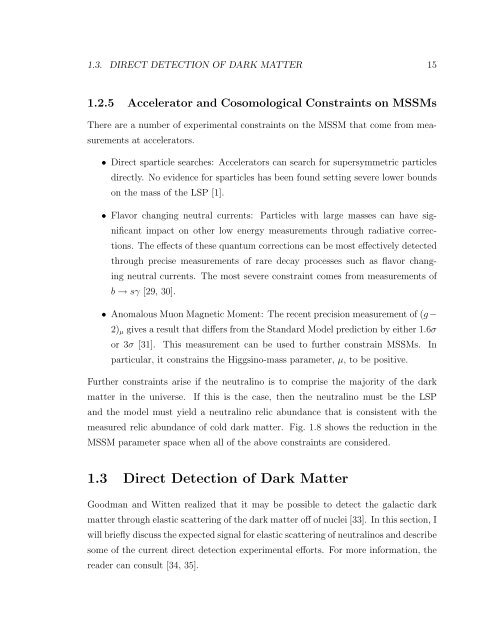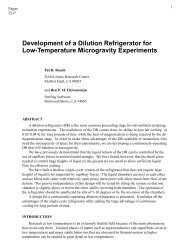cdms-ii - CDMS Experiment - University of California, Berkeley
cdms-ii - CDMS Experiment - University of California, Berkeley
cdms-ii - CDMS Experiment - University of California, Berkeley
You also want an ePaper? Increase the reach of your titles
YUMPU automatically turns print PDFs into web optimized ePapers that Google loves.
1.3. DIRECT DETECTION OF DARK MATTER 15<br />
1.2.5 Accelerator and Cosomological Constraints on MSSMs<br />
There are a number <strong>of</strong> experimental constraints on the MSSM that come from measurements<br />
at accelerators.<br />
• Direct sparticle searches: Accelerators can search for supersymmetric particles<br />
directly. No evidence for sparticles has been found setting severe lower bounds<br />
on the mass <strong>of</strong> the LSP [1].<br />
• Flavor changing neutral currents: Particles with large masses can have significant<br />
impact on other low energy measurements through radiative corrections.<br />
The effects <strong>of</strong> these quantum corrections can be most effectively detected<br />
through precise measurements <strong>of</strong> rare decay processes such as flavor changing<br />
neutral currents. The most severe constraint comes from measurements <strong>of</strong><br />
b → sγ [29, 30].<br />
• Anomalous Muon Magnetic Moment: The recent precision measurement <strong>of</strong> (g−<br />
2) µ gives a result that differs from the Standard Model prediction by either 1.6σ<br />
or 3σ [31]. This measurement can be used to further constrain MSSMs. In<br />
particular, it constrains the Higgsino-mass parameter, µ, to be positive.<br />
Further constraints arise if the neutralino is to comprise the majority <strong>of</strong> the dark<br />
matter in the universe. If this is the case, then the neutralino must be the LSP<br />
and the model must yield a neutralino relic abundance that is consistent with the<br />
measured relic abundance <strong>of</strong> cold dark matter. Fig. 1.8 shows the reduction in the<br />
MSSM parameter space when all <strong>of</strong> the above constraints are considered.<br />
1.3 Direct Detection <strong>of</strong> Dark Matter<br />
Goodman and Witten realized that it may be possible to detect the galactic dark<br />
matter through elastic scattering <strong>of</strong> the dark matter <strong>of</strong>f <strong>of</strong> nuclei [33]. In this section, I<br />
will briefly discuss the expected signal for elastic scattering <strong>of</strong> neutralinos and describe<br />
some <strong>of</strong> the current direct detection experimental efforts. For more information, the<br />
reader can consult [34, 35].




